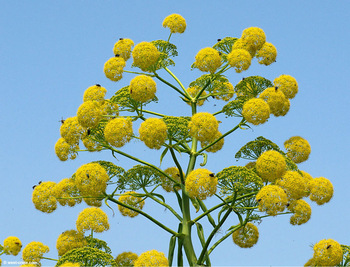Ferula asafetida
The old traditional phytomedicine asafoetida, an oleo-gum-resin obtained from the roots of different Ferula assa-foetida, is used in different countries for various purposes. Asafoetida is not only used as a culinary spice but also traditionally used to treat various diseases, including asthma, gastrointestinal disorders, intestinal parasites, etc. This oleo-gum-resin has been known to possess antifungal, anti-diabetic, anti-inflammatory, anti-mutagenic and antiviral activities. A wide range of chemical compounds including sugars, sesquiterpene coumarins and polysulfides have been isolated from this plant. Recent studies have shown new promising antiviral sesquiterpene coumarins from this old phytomedicine.Spices are used for thousands of years as food accessories to enhance the sensory quality of food. By imparting pleasant flavor, color and pungency, they can transform an otherwise dull food preparation into an attractive, appetizing meal. Spices are used not only alone, but also in the form of mixtures known as curry powders to math different tastes and preparations. Spices are known to possess several medicinal properties. A number of health favorable physiological effects of dietary spices have been experimentally documented in recent decades.Asafetida is used as a flavoring agent in food and as a traditional medicine for many diseases in many parts of the world. Asafoetida (Ferula asafoetida) is an oleo-gum-resin obtained from the stems of Ferula plants belonging to the family Umbelliferae. Out of more than 170 species, sixty spices of Ferula are widely distributed in Central Asia, particularly West Afghanistan, Eastern Iran and North Africa. Asafetida is one of the important species of Ferula and is more native to Afghanistan and Iran than grows about 2 m in height and is in two types bitter and sweet.Asafoetida is extracted from the Ferula plants which have massive taproots or carrot-shaped roots, around 15 cm in diameter at the crown when they are 4–5 years old. Before the plants flower, the upper part of the living rhizome root is laid bare and the stem cut off close to the crown. A dome-shaped structure made of twigs and earth covers the exposed surface.Asafoetida has a strong, tenacious and sulfurous odor. Nowadays it is a popular ingredient in the Indian cuisine, most probably because its odor is reminiscent of the flavor of garlic and onion, two sprouting vegetables.

